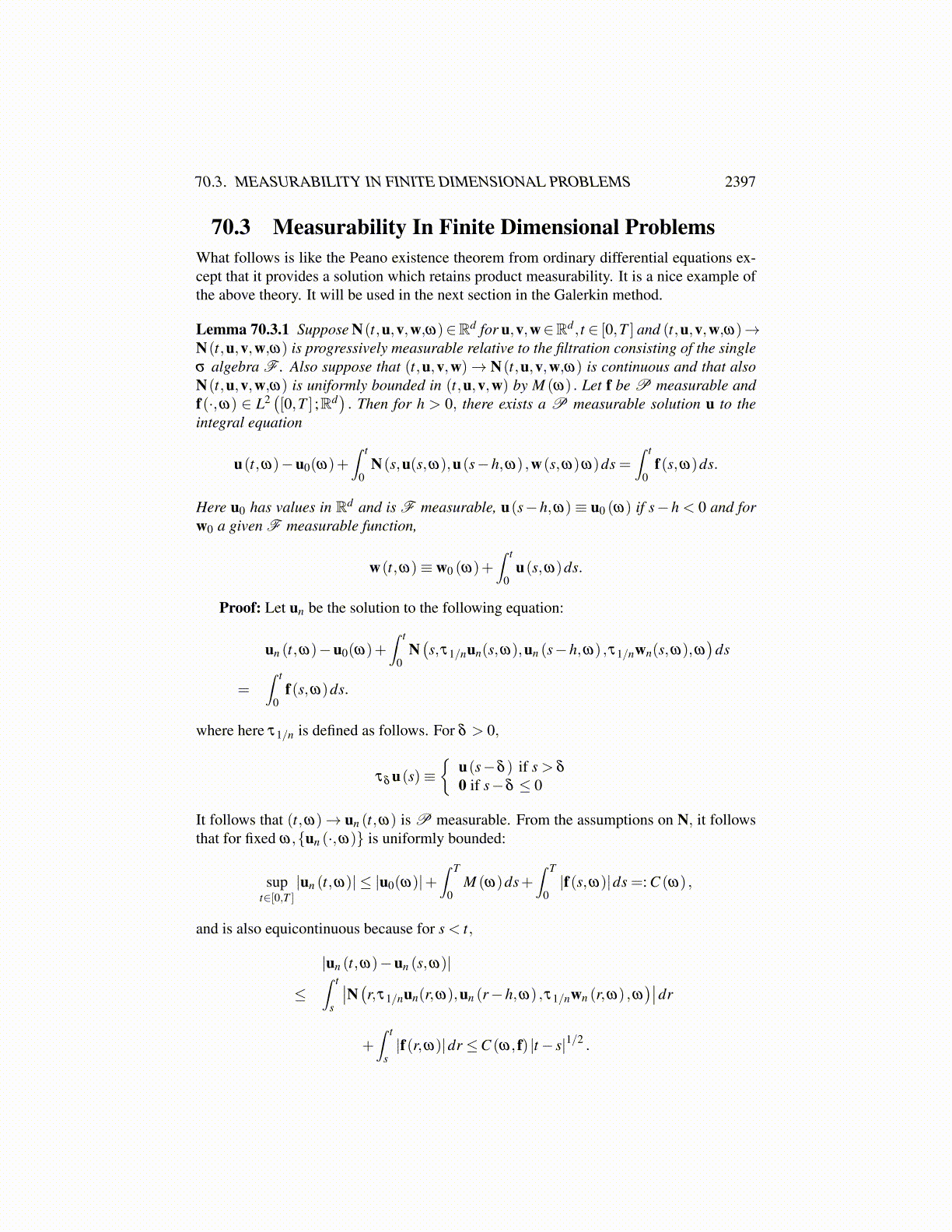
70.2. A MEASURABLE SELECTION 2397
for each t.Note that it is not clear that (t,ω)→ f
(un(ω) (t,ω)
)is P measurable although (t,ω)→
γ (t,ω) is P measurable.Proof of the theorem: By assumption, there exists a further subsequence still denoted
by n(ω) such that, in addition to 70.2.2 above, the weak limit
limn(ω)→∞
un(ω) (·,ω) = u(·,ω)
exists in Lp′ ([0,T ] ;V ′) such that t→ u(t,ω) is weakly continuous into V ′. Then the aboveequation 70.2.2 continues to hold for this further subsequence and in addition to this,
mk
∫ t
lmk (t)
⟨φ rk
,u(s,ω)⟩
V,V ′ds = lim
n(ω)→∞
mk
∫ t
lmk (t)
⟨φ rk
,un(ω) (s,ω)⟩
V,V ′ds = γk (t,ω)
Letting φ ∈ D given, there exists a sub-sequence denoted by k such that mk → ∞ andφ rk
= φ for all k. Then passing to a limit and using the assumed continuity of s→ u(s,ω) ,the left side of this equation converges to ⟨φ ,u(t,ω)⟩V,V ′ and so the right side, γk (t,ω)must also converge, this for each ω . Since the right side is a product measurable functionof (t,ω) , it follows that the pointwise limit is also product measurable. Hence (t,ω)→⟨φ ,u(t,ω)⟩V,V ′ is product measurable, this for each φ ∈ D . Since D is a dense set, itfollows that (t,ω)→ ⟨φ ,u(t,ω)⟩V,V ′ is P measurable for all φ ∈ V and so by the Pettistheorem, [127], (t,ω)→ u(t,ω) is P measurable into V ′.
One can say more about the measurability of the approximating sequence. In fact, wecan obtain one for which ω → un(ω) (t,ω) is also F measurable.
Lemma 70.2.6 Suppose, un(ω) → u weakly in Lp′ ([0,T ] ;V ′) where u is product measur-able measurable and
{un(ω)
}is a subsequence of {un} where
supt∈[0,T ]
∥un (t,ω)∥V ′ <C (ω) , for ω /∈ N a set of measure zero,
Then for each ω /∈ N, there exists a subsequence of {un} denoted as{
uk(ω)
}such that
uk(ω)→ u weakly in Lp′ ([0,T ] ;V ′), ω → k (ω) is F measurable, and ω → uk(ω) (t,ω) isalso F measurable, the last assertions holding for all ω /∈ N.
Proof: For f ,g ∈ Lp′ ([0,T ] ;V ′) ≡ V ′, Lp ([0,T ] ;V ) ≡ V , let {φ k} be a countabledense subset of Lp ([0,T ] ;V ). Then a bounded set in Lp′ ([0,T ] ;V ′) with the weak topologycan be considered a complete metric space using the following metric.
d ( f ,g)≡∞
∑j=1
2− j
∣∣∣⟨φ k, f −g⟩V ,V ′
∣∣∣1+∣∣∣⟨φ k, f −g⟩V ,V ′
∣∣∣Now let k (ω) be the first index from the indices of {un} at least as large as k such that
d(uk(ω),u
)≤ 2−k